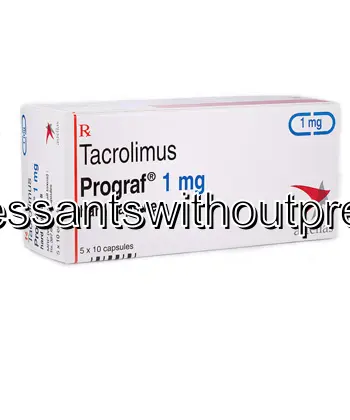| Package | Dosage | Price | Price per Dose | |
|---|---|---|---|---|
| Dosage: 0,5mg | ||||
| 90 pill | 0,5mg | AUD860.05 | AUD9.54 | |
| 60 pill | 0,5mg | AUD611.21 | AUD10.20 | |
| 30 pill | 0,5mg | AUD340.62 | AUD11.35 | |
| 20 pill | 0,5mg | AUD239.15 | AUD11.96 | |
| 10 pill | 0,5mg | AUD128.02 | AUD12.90 | |
| Dosage: 1mg | ||||
| 90 pill | 1mg | AUD1,207.95 | AUD13.43 | |
| 60 pill | 1mg | AUD864.88 | AUD14.42 | |
| 30 pill | 1mg | AUD509.74 | AUD16.96 | |
| 20 pill | 1mg | AUD379.28 | AUD18.94 | |
| 10 pill | 1mg | AUD212.58 | AUD21.36 | |
| Dosage: 5mg | ||||
| 20 pill | 5mg | AUD1,152.38 | AUD57.57 | |
| 10 pill | 5mg | AUD645.03 | AUD64.48 | |

Tacrolimus Description
Overview of Tacrolimus
Tacrolimus is an immunosuppressant medication primarily used to prevent organ rejection in transplant patients. It belongs to a class of drugs known as calcineurin inhibitors. This medication works by suppressing the activity of the immune system, which can recognize the transplanted organ as foreign and attack it. Tacrolimus is often prescribed after kidney, liver, or heart transplants to enhance the likelihood of successful organ acceptance. Its effectiveness has made it a vital component in transplant medicine, ensuring better long-term outcomes for recipients.
Effectiveness and Benefits
Many users find Tacrolimus highly effective in reducing the risk of organ rejection. Its ability to inhibit T-lymphocyte activation makes it a powerful tool for maintaining transplant health. Patients often notice a significant decrease in immune response activity, which is essential immediately following transplantation. Moreover, Tacrolimus can sometimes be used in the treatment of certain autoimmune conditions, although this is less common.
One notable advantage of Tacrolimus is its potency. When correctly dosed, it offers a strong level of immunosuppression with manageable side effects for most patients. This medication has contributed to increased survival rates and improved quality of life for transplant recipients worldwide.
Administration and Dosage
Tacrolimus is typically administered orally, in capsule or liquid form. The dosage varies depending on the patient's weight, age, and the type of transplant received. It often requires regular blood tests to monitor drug levels in the bloodstream, ensuring they stay within a therapeutic window. Proper adherence to the prescribed regimen is crucial to prevent organ rejection and reduce potential toxicity.
In some cases, healthcare providers may adjust the dose based on response and side effects. It is essential that patients follow their medical instructions closely and do not alter the dose without consulting their doctor.
Possible Side Effects and Risks
While Tacrolimus is generally effective, it can cause side effects. Common issues include tremors, headaches, high blood pressure, and increased susceptibility to infections due to suppressed immune function. Some patients may experience gastrointestinal disturbances, such as nausea or diarrhea.
More serious, but less frequent, side effects can involve kidney toxicity, neurological effects, or metabolic changes like increased blood sugar levels. Long-term use may also elevate the risk of certain malignancies, including skin cancers. Regular monitoring by healthcare professionals helps minimize these risks and manage any adverse effects promptly.
Precautions and Interactions
Before starting Tacrolimus, patients should inform their healthcare provider about any other medications they are taking, including over-the-counter drugs and supplements. Several medicines can interact with Tacrolimus, altering its effectiveness or increasing toxicity. Notably, drugs such as antifungals, certain antibiotics, and some blood pressure medications can interact negatively.
Patients with pre-existing conditions like kidney issues, liver problems, or high blood pressure should exercise caution and be under close medical supervision during treatment. Additionally, avoiding exposure to sunlight and UV rays is advisable, as Tacrolimus can increase skin sensitivity and the risk of skin cancer.

